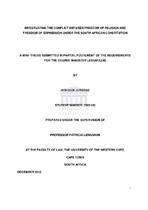| dc.contributor.advisor | Lenaghan, Patricia | |
| dc.contributor.author | Jurgens, Hishaam | |
| dc.date.accessioned | 2015-05-04T08:20:43Z | |
| dc.date.available | 2015-05-04T08:20:43Z | |
| dc.date.issued | 2012 | |
| dc.identifier.uri | http://hdl.handle.net/11394/4099 | |
| dc.description | Magister Legum - LLM | en_US |
| dc.description.abstract | This mini-thesis is based on the presumption that the Danish cartoons and the anti-Muslim clip
posted on YouTube as forms of expression, ridiculed the religious beliefs and practices of
Muslims which in turn affected the exercise of religious freedom as it violated the dignity of the
bearers of the right to freedom of religion and therefore a conflict between the right to freedom of
religion and freedom of expression exists.
The above incidence of conflict between the right to
freedom of religion and freedom of expression involves infringing the freedom of religion of the
Islamic community.
Blasphemy in Islam is speech that is insulting to God, but during the
course of Muslim history it has become increasingly linked with insult to the Prophet
Muhammad.
In Islam the depiction of the Prophet Muhammad in any way is strictly forbidden
and is considered blasphemous. | en_US |
| dc.language.iso | en | en_US |
| dc.publisher | University of the Western Cape | en_US |
| dc.subject | Religious dignity | en_US |
| dc.subject | Freedom of religion | en_US |
| dc.subject | Freedom of expression | en_US |
| dc.subject | Conflict of rights | en_US |
| dc.subject | International human rights law | en_US |
| dc.subject | Sharia law | en_US |
| dc.subject | Salman Rushdie | en_US |
| dc.subject | Mohammed cartoons | en_US |
| dc.subject | Limitation clause | en_US |
| dc.subject | Hierarchy of rights | en_US |
| dc.title | Investigating the conflict between freedom of religion and Freedom of expression under the South African constitution | en_US |
| dc.type | Thesis | en_US |
| dc.rights.holder | University of the Western Cape | en_US |

